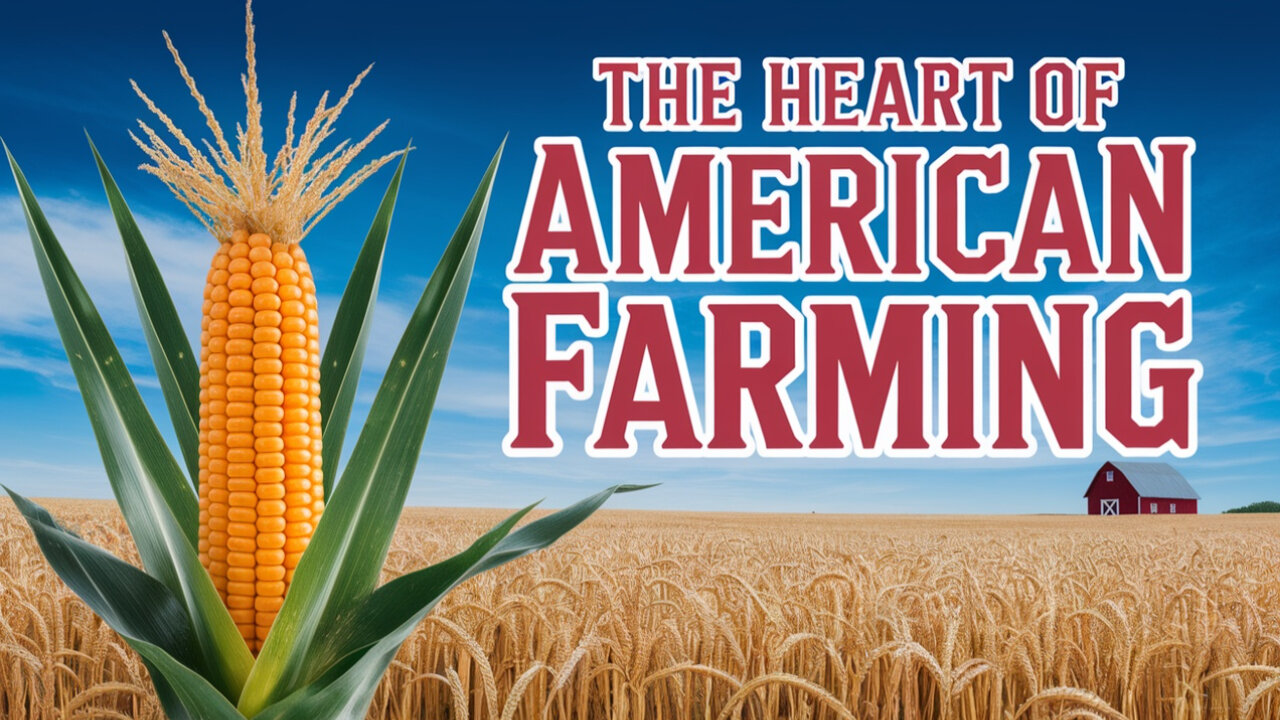Premium Only Content

The Heart of American Farming #farming #trending #new #food
Today we dive into the heart of American agriculture! We’re exploring the top five crops that fuel our economy, feed our livestock, and clothe our nation—corn, soybeans, hay, wheat, and cotton. We’ll break down why they matter, where they grow, and how they shape our lives. Don’t forget to LIKE, Share, and SUBSCRIBE!
First, the king of crops: corn. Picture fields across the Midwest, golden stalks under a big blue sky. In two thousand twenty-three, farmers planted about ninety-three million acres of corn—roughly the size of California! The United States leads the world, producing around five hundred million metric tons last year. About forty percent goes to livestock feed, keeping cows, pigs, and chickens happy. Another forty-five percent becomes ethanol for biofuel. The rest? It’s in cereal, soda, and ketchup as high-fructose corn syrup.
Corn’s economic impact is huge, raking in about seventy-eight billion dollars in two thousand twenty-three. The Corn Belt—Iowa, Illinois, Nebraska—is its heart, with fertile soil and modern tech driving big yields. But weather like drought can hurt harvests, and farmers tweak hybrids for resilience. Corn’s been a staple since Native Americans domesticated it thousands of years ago, and today, it’s America’s agricultural backbone.
Next, soybeans, the runner-up with global reach. In two thousand twenty-three, soybeans covered about eighty-two million acres, mostly in the Midwest—Iowa, Illinois, and Minnesota. The United States leads, producing around one hundred thirteen million metric tons last year. Soybeans are a protein powerhouse—seventy percent feeds livestock, fifteen percent becomes cooking oil, and five percent powers biodiesel. Tofu or soy milk? That’s soybeans, too!
Soybeans brought in about fifty billion dollars in two thousand twenty-two, with exports to China driving demand. But trade tensions, like tariff threats with Mexico, and competition from Argentina keep farmers alert. Soybeans came to America from Asia in the eighteen hundreds and boomed in the twentieth century as a feed crop. They’re a symbol of American ingenuity, turning a humble bean into a global commodity.
Now, a quieter giant: hay. It covered about fifty-three million acres in two thousand twenty-three, the third-largest crop by land use, grown in Texas, Montana, and the Great Plains. Hay feeds livestock, especially cattle, for beef and dairy. It’s not flashy, but without hay, our burgers and milkshakes would suffer.
Hay doesn’t grab headlines, and its acreage has dipped as farmers chase higher-value grains. Still, it’s the unsung hero of animal agriculture, supporting ranches nationwide. Historically, hay was cut by hand in the eighteen hundreds. Now, massive balers do the work, and hay remains a steady force in America’s livestock industry.
Our fourth crop is wheat, the backbone of bread and pasta. Wheat spanned about forty-six million acres in two thousand eighteen, with recent declines. Kansas, North Dakota, and Oklahoma are the wheat heartland, part of the Great Plains. The United States is the world’s fourth-largest wheat producer, harvesting about fifty million tonnes in two thousand eighteen.
Seventy percent is winter wheat, planted in fall and harvested in summer, ideal for all-purpose flour. The rest feeds livestock or gets exported. Wheat arrived with European settlers in the sixteen hundreds, but today, farmers face lower profits and competition from Russia. Still, every slice of toast owes a debt to America’s wheat fields.
Finally, cotton, the fabric of our lives. Cotton hits about ten to twelve million acres recently, with a sixteen-point-seven percent jump in two thousand eleven. Texas grows about forty-nine percent, joined by Arizona and Mississippi. The United States is the third-largest cotton producer and top exporter, earning about twenty-one billion dollars yearly and supporting one hundred twenty-five thousand jobs.
Cotton ruled the South since the eighteen hundreds, tied to the painful legacy of slavery. Today, it’s about textiles—T-shirts, jeans—with global demand setting the pace. Prices and weather can make or break a season, but cotton endures. The cotton gin, invented by Eli Whitney in seventeen ninety-three, made America a cotton powerhouse.
So, there you have it—corn, soybeans, hay, wheat, and cotton. These crops aren’t just plants; they’re the engine of American agriculture, feeding us, fueling us, and dressing us. Corn and soybeans made up over fifty percent of crop receipts in two thousand twenty-two, while hay supports livestock, wheat fills pantries, and cotton clothes the world. These crops tell a story of innovation and hard work.
Thanks for joining this crop tour! Want to dig deeper—or explore ties to American culture, like trucker hats from farm life? Let me know, and we’ll keep the conversation growing!
-
 16:30
16:30
Clintonjaws
7 hours ago $2.30 earnedEntire Room Speechless as Pete Hegseth Snaps Destroying All Media To Their Face
12.9K8 -
 22:12
22:12
Dad Saves America
3 hours agoHow Greek Philosophers Created Western Civilization: The Death of Debate - Pt 2
3.28K -
 LIVE
LIVE
LFA TV
20 hours agoLIVE & BREAKING NEWS! | WEDNESDAY 12/03/25
1,247 watching -
 1:05:46
1:05:46
The Quartering
4 hours agoNew Epstein Video Drops! The US Economy Has SCARY Numbers Released & More
116K26 -
 1:07:11
1:07:11
The White House
7 hours agoPresident Trump Makes an Announcement, Dec. 3, 2025
32K15 -
 1:26:28
1:26:28
Film Threat
22 hours agoINSIDE THE DECLINE OF DISNEY! A WARNING FROM THE PAST | Hollywood on the Rocks
14.9K1 -
 1:15:43
1:15:43
DeVory Darkins
5 hours agoDISTURBING: Gavin Newsom makes FATAL MISTAKE after Criminal Illegal Alien kills 11 year old boy
128K81 -
 2:53:35
2:53:35
MattMorseTV
4 hours ago $15.76 earned🔴Trump's HUGE ANNOUNCEMENT.🔴
49.6K47 -
 1:18:21
1:18:21
Sean Unpaved
6 hours agoArch Manning & Texas ELIMINATED From College Football Playoff Contention | UNPAVED
46.6K3 -
 1:59:06
1:59:06
The Charlie Kirk Show
6 hours agoBlackpilled Zoomers + Charlie's Sabbath + Minnesota Meltdown | Bowyer, Turek, Glahn | 12.3.2025
81.1K35